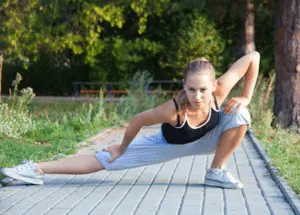
- Share on Facebook27
- Share on Pinterest
- Share on Twitter
Flexibility is one of the most misunderstood concepts in health. For some reason, we seem to think that flexibility is synonymous with health and fitness. In actuality, the fact that you can do a split does not necessarily make you any more fit than someone who cannot touch their toes.
Hyper-flexibility could makes one very much prone to injury. It is not necessary, and can actually be counter productive, for most of us to aspire to be as flexible as the gymnast, contortionist or yoga master. What is desirable, on the other hand, is to work on having a good range of motion.
Flexibility Defined
The real definition of flexibility is that you have a good range of motion within your joints. Attaining and maintaining joint mobility is essential, especially as we age. Flexibility is a term given to a joint or a group of joints, not to an entire person. Many people are flexible in one way but not another. For example, the person who can do the splits may be able to split forwards but not sideways.
When we don’t have a great range of motion in certain joints we can easily injure ourselves. Properly conditioning joints is critical to avoiding injuries. On the other hand, overstretching can cause major damage to joints. It is never wise to force a muscle or joint into a particular motion. This can cause damage to connective tissues and result in pain and injury.
Range of Motion is Personal
Many biomechanists and physical therapists are beginning to realize that there is no benefit in stretching a muscle or a ligament beyond it adequate range of motion. Everyone has their own personal best range of motion. Pushing beyond this point is not necessary and can be detrimental. Further, research has demonstrated that people who have hypermobile joints may be at a greater risk of osteoarthritis. Some people are just naturally more flexible than others. While flexibility is an asset in some activities such as swimming and yoga, it can be dangerous is contact sports. If we listen to our bodies, we will be able to figure out how naturally flexible we are.
What is the Beighton Index Test?
If you want to determine just how flexible you already are, you can takel the Beighton Index Test. Although you can do this test at home, it is helpful to have someone assist you.
Step One
Take off your shoes and stand straight with your feet hip distance apart. Keep your knees straight. Bed over at the hips and try to place the palms of your hands flat on the floor. If you can do this, give yourself one point.
Step Two
Stand straight and lock your knees. Ask a friend to see whether or not your knees go beyond straight – bowing back. If this happens, give yourself one point for each knee that bows.
Step Three
Bring your arms out to your sides with your palms up. Straighten and lock your elbows. If they go beyond straight – give yourself one point for each one that bows.
Step Four
Place the palm of your hand and forearm on a table. Check to see if you can easily bend your little finger to 90 degrees. Give yourself one point for each finger that goes to 90 degrees.
Step Five
Check to see if you can easily bend your thumb to your wrist. Give yourself one point for each thumb that touches.
Add up all of your points. If you scored four or more, you are hypermobile. If you have joint pain and scored more than four, you may want to check with your physician.
Why Stretch?
The aim of stretching is to take care of your joints so that they can function at their full range of motion. Gentle stretching throughout the day is recommended for everyone. This does not mean stretching to the point of pain but rather stretching until you feel a slight pull and letting go. This type of stretching will help us attain and maintain our full range of motion.
Most of us were taught that we needed to stretch before engaging in physical activity. Remember, we were told to hold each stretch for 30 seconds and not to bounce? Well, the school of thought on this one has changed. Exercise specialists now believe that stretching does not actually improve performance or protect against injury.
One study published in the Journal of Strength and Conditioning states that if you stretch before lifting weights you can actually feel weaker and less in control during your workout. This study, along with others, indicates that stretching before activity can even be counterproductive.
 Researchers at the University of Zagreb in Croatia studied research data from over 100 studies that used static stretching alone as the only warm-up exercise before activity. According to the results of their research investigation, static stretching reduced the strength in a stretched muscle by 5.5 percent, more if the stretch was held for 90 seconds of more.
Researchers at the University of Zagreb in Croatia studied research data from over 100 studies that used static stretching alone as the only warm-up exercise before activity. According to the results of their research investigation, static stretching reduced the strength in a stretched muscle by 5.5 percent, more if the stretch was held for 90 seconds of more.
Participants were also less powerful in terms of the muscle’s ability to produce force during contractions. It was also determined that explosive muscular performance drops when stretching occurs first, by as much as 2.8 percent. Therefore, someone who is driving out of the starting blocks for a sprint will perform worse if they stretch versus if they had not warmed up at all. The same is true for other activities that require a quick burst of energy.
Stretching appears to do what it is supposed to, loosen up muscles and tendons. However, in the process of doing so it makes them less able to hold energy and jump into action. It is sort of like an old rubber band that no longer has its spring.
Although most studies have been done on activities that involve strength and explosive power, there is evidence to believe that the same may hold true for distance running and cycling.
What is the Best Warm Up?
Experts say that the best warm up is one that includes performance. So, you are better to warm up dynamically than statically, working the muscles that you are going to use in the activity you are participating in. Things like jumping jacks and high leg kicks may better prepare the body for performance than stretching. Stretching after a workout or physical event is still recommended.
– The Alternative Daily
Sources:
http://well.blogs.nytimes.com/2013/04/03/reasons-not-to-stretch/
http://www.runnersworld.com/stretching/does-stretching-prevent-injuries
- Share on Facebook27
- Share on Pinterest
- Share on Twitter

